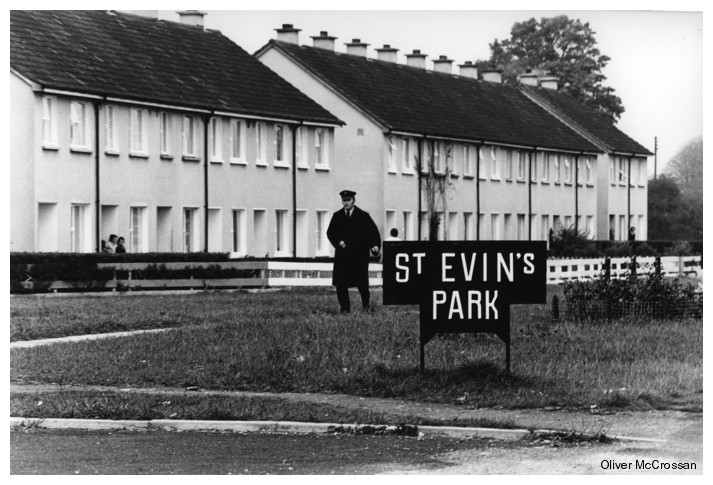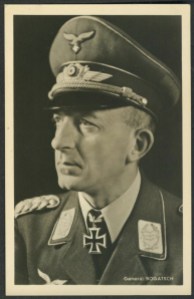Before you all start telling me I should look back at the history books, I know that Ireland was never invaded by the Germans during WWII. Except for the Belfast Blitz(pictures above) the island of Ireland remained unscathed during the war. The republic of Ireland was neutral, but I believe more due to it’s geographical location it wasn’t invaded rather then it’s political neutrality. Had it been between France and Britain I think Ireland would have been occupied by the Germans.

However, this doesn’t mean the Germans had no plans for Ireland. There were several planned operations foe the invasion of Ireland the main ones being ‘Operation Green’ and Operation Dove'(sometimes also referred to as ‘Operation Pigeon’) .
Hitler loved the idea of Ireland and was a great admirer of Irish Folk music, in fact in 1936 he had invited Sean Dempsey ,uileann pipe player, to play for him in Berlin.
Dublin was earmarked by the Nazis as one of six regional administrative centers for Britain and Ireland right after Dunkirk when an Allied collapse seemed imminent.
Had the occupation taken place, the Germans thought it crucial that their advancing units reach Ireland as soon as possible after the initial invasion.
The plan would have seen the fourth and seventh infantry divisions of the Germany Army being deployed to Ireland. The German 4th army corps in particular had a brutal reputation in battle and inflicted many civilian casualties as they secured the Polish corridor to Warsaw during the invasion of Poland in 1939.
Their advance, had the fourth and seventh been deployed to Ireland, would have been rapid – up to 100km a day – and their brutality would have been beyond doubt.
Fifty thousand troops in total were allocated for the Irish invasion with an initial batch of 4,000 crack engineers, motorised infantry, commando and panzer units to reach the Irish shore after having launched from France.
Operation Dove (“Unternehmen Taube” in German) also sometimes known as Operation Pigeon, was an Abwehr sanctioned mission devised in early 1940. The plan envisioned the transport of IRA Chief of Staff Seán Russell to Ireland, and on the arrival of Frank Ryan in Berlin three days before the launch of the operation, it was also decided to transport him during the operation.
Seán Russell had arrived in Berlin on 5 May 1940, four days after arriving in Genoa from the United States.Russell was informed of Operation Mainau, the plan to parachute Dr. Hermann Görtz into Ireland. Russell was asked to brief Görtz on Ireland before his departure that night, but missed his takeoff from the Fritzlar airfield near Kassel.
By 20 May, Russell had begun training with Abwehr in the use of the latest German explosive ordnance. This training was conducted at the Abwehr training school/lab in Berlin-Tegel, which specialised in the design of explosives as everyday objects. Russell also visited the training area for the Brandenburg Regiment, the ‘Quenzgut,’ where he observed trainees and instructors working with sabotage materials in a field environment. Because he received explosives training, his return to Ireland with a definite sabotage objective was planned by German Intelligence. His total training time with German Intelligence lasted over three months.
While Görtz had landed successfully, the capture of the German agents from Operation Lobster I did not prevent Abwehr chief Wilhelm Canaris allowing the transport of Russell to continue. Both Russell and Frank Ryan departed aboard U-65 from Wilhelmshaven on 8 August — the mission was dubbed Operation Dove.

Russell became ill during the journey and complained of stomach pains. U-65 was not staffed with a doctor and he died on 14 August 100 miles short of Galway. He was buried at sea and the mission aborted.
Operation Green (German: Unternehmen Grün) often also referred to as Case Green (Fall Grün) or Plan Green (Plan Grün), was a full-scale operations plan for a German invasion of Ireland in support of Operation Sea Lion (the plan to invade the UK). Despite its detailed nature, Green is thought to have been designed only as a credible threat, a feint, not an actual operation. Plan W, a planned occupation of all of the state by British forces, was drafted by the British military in secret liaison with the Irish government to counteract any German invasion.
German interest in Green and Operation Sea Lion must always be understood in the context of their overall strategic plan. That, first and foremost, was Operation Barbarossa, the invasion and destruction of the Soviet Union. They had little interest in tying up military resources in England or France, other than doing what was necessary to prevent the British and French from interfering with the invasion of the Soviet Union. During Britain’s darkest hour, the Germans were, in fact, secretly marshalling most of their resources to attack their ally in the occupation of Poland: the Soviet Union.
Implementation of Green was the responsibility of General der Flieger Leonhard Kaupisch, commander of the German Fourth and Seventh Army Corps, Army Group B. The originator of the idea for Green is thought to be newly promoted Field Marshal Fedor von Bock, Army Group B.
Bock had operational command for the western flank under Operation Sea Lion. Once collated, thirty-two copies of Green were distributed as “Top Secret” on 8 August 1940 to the German High Command; a number of copies survived World War II.
Green was conceived in early- to mid-1940 and the plan was drawn up in August 1940, under three weeks after Hitler issued his initial warning order for Operation Sea Lion on 16 July 1940. The plan was widely circulated and even publicised during the period 1940–1941. By 1942 Green had even made its way into the hands of the Irish military via the British military and was subsequently translated into English by Irish Military Intelligence G2 Branch. This has raised suspicion that intercepted ‘chatter’ about Green may have been aimed at creating a ‘bogeyman’ in the minds of British military planners on their western flank. There was some truth to this; one example is General major Walter Warlimont’s recollection from 28 June 1940 of an operational instruction issued by the High Command. The directive was to mislead the enemy on a possible invasion of neutral Ireland using “all available information media”.

The intention was to spread rumours that German forces were preparing a landing in Ireland to place a further stranglehold on Britain, reinforcing the current “siege”.It is possible that these efforts heightened the state of alert and were a cause of alarm in Britain, leading to the British expending significant effort in trying to convince the Irish government to abandon neutrality and side with the Allies.
Despite the propaganda, Green was an actual military plan that was given real consideration. Although Hitler had postponed Sea Lion on 17 September 1940, he took up a personal interest again on 3 December 1940 after hearing of radio reports alluding to a British invasion of Ireland. Hitler then ordered Raeder’s naval staff to investigate the feasibility of occupying Ireland to pre-empt any British attempt. However, at the time Hitler seemed already convinced that any landing should be by invitation only:
“..a landing in Ireland can be attempted only if Ireland requests help. For the present our envoy [assumed to be Dr. Eduard Hempel of the German Legation] must ascertain whether De Valera desires support and whether he wishes to have his military equipment supplemented by captured British war material (guns and ammunition), which could be sent to him in independent ships. Ireland is important to the Commander in Chief, Air, [Göring] as his base for attacks on the north-west ports of Britain, although weather conditions must be investigated. The occupation of Ireland might lead to the end of the war
The operatives were initially to land on Ireland’s South-East coast where they expected to be met with only token resistance, and then to aerially bomb targets throughout the Irish Free State as it was then known.
After this initial landing and advancement phase, ground troops of the 4th and 7th army corps would have begun so-called “probing attacks” on the Irish Army based in Cork and Clonmel, followed by a push through Laois-Offaly towards the Army’s Curragh Camp base in Co. Kildare.
Some units would have reached the outskirts of Dublin just 48 hours after having landed in the South-East, such would have been the pace of their progress.

The Nazi politburo in Dublin was to have far reaching executive powers and would have had instructions to dismantle, and if necessary, liquidate, any of Ireland’s remaining indigenous political apparatus, intellectual leadership and any non-Aryan social institutions. The GAA (Gaelic Athletic Association) would have been closed and Irish Jews would have been murdered en masse.
Beach-heads considered in Green included the Waterford-Wexford sector (favoured), the estuary of the River Shannon near Limerick,

Galway Bay, Donegal Bay with Killala, Ballina and Sligo,Lough Foyle with Derry, the ‘Bay of Belfast’ (Belfast Lough), and Cobh in Cork.
The landings were to be effected by sea craft available in occupied France at the time, but there were few in existence and Operation Sea Lion was to have priority- further reasons why Raeder was not happy with Green. Green was expected to utilise over 50,000 German troops and Sea Lion was expected to use 160,000 but for Green the Germans only found two steamships available around the north-western ports of France- the French Versailles and the German Eule together with three small coasters: Mebillo, Clio and Franzine.
It is also worth pointing out that to get to Ireland the departing ships would have had to circumnavigate the British coastline at Cornwall. Every vessel taking part in Green was to carry anti-aircraft weaponry indicating that the planners expected the Royal Air Force (RAF) to intercept them, although air cover from the Luftwaffe’s West of France Air Command was to be provided as part of Sea Lion.
Ireland would have been ruthlessly subject to German martial law, with curfews also being imposed on the local population, as well as plans to commandeer resources from locals. To this end an annex was added to the plan listing all petrol stations and garages in Munster and the Midlands. Nothing wasn’t planned for.
Livestock, food, fuel, and forced labor would all have been used by the Germans in their advance northwards, which would have pitted them squarely against the civilian population.
Ireland’s army at the time of 7,600 regulars and 11,000 reserves would have been completely unable to handle the onslaught from the invading force. The army was also incapable of mounting large-scale maneuvers and was poorly armed. Many companies even traveled by bicycle!
There was no involvement or prior knowledge of Green by the IRA in Ireland.

It is likely, however, that the possibility of such planning was on the mind of Sean Russell and his acting Chief of Staff Stephen Hayes. Russell is known to have reached out to the German Foreign Ministry and Abwehr during his time in Berlin, and Hayes is known to have sanctioned Plan Kathleen before it was delivered to the Abwehr in Berlin in August 1940. However, no operational instructions were issued to Abwehr agents to gather data on Ireland in preparation for Green. This is possibly because the planners felt they had enough militarily useful data already, but likely because Green, although thorough, was created in a hurry. Later editions contained no data from the IRA.
When Winston Churchill got wind of the German plans, he drafted detailed plans for a counter-attack to be launched from Northern Ireland. The plan, codenamed Plan W, envisaged the Irish and British armies fighting side by side to repel the intrusive German forces.
Ireland’s neutrality was respected and they emerged largely unscathed from the war, but had the invasion taken place, there could well have been large-scale casualties.







































































You must be logged in to post a comment.